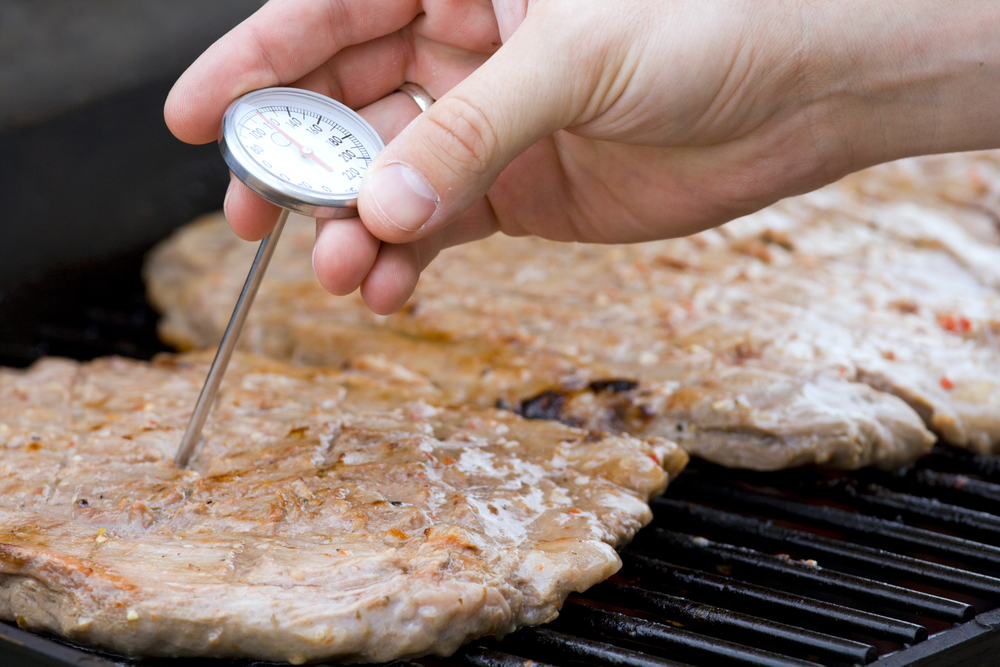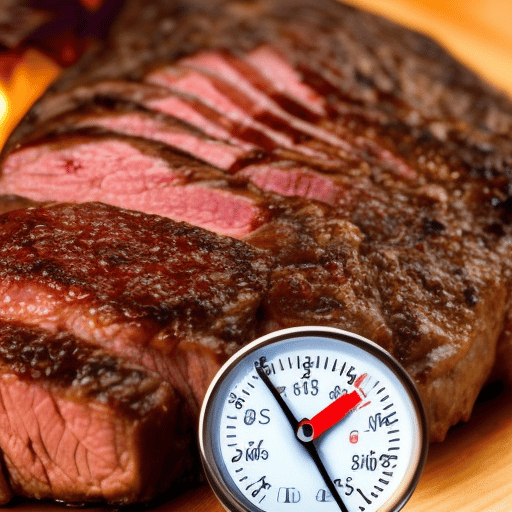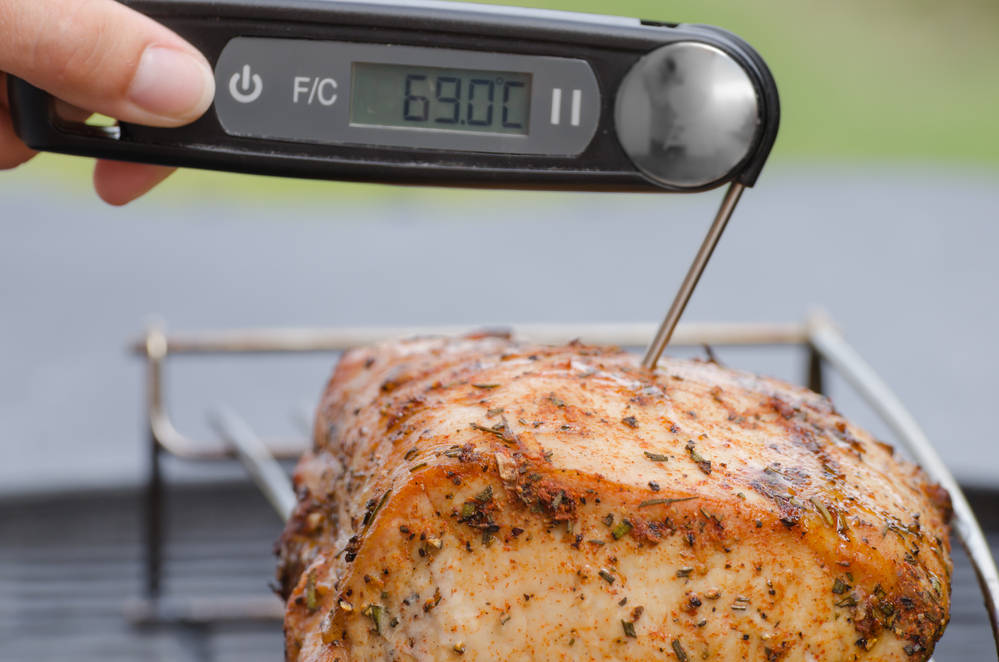Encourage food safety in your home with meat thermometers that let you achieve the desired internal temperature of your food while you cook. By taking various heat temperatures, these cooking tools can detect the difference of a few degrees. Let’s discover how does a meat thermometer work in today’s article.
What Is a Meat Thermometer?
A meat thermometer measures the internal heat temperature of meats while you’re cooking. A probe thermometer is designed for poultry, lamb, pork, beef, and more and ensures that your food is safely cooked to avoid any foodborne illnesses. Moreover, a meat thermometer displays temperatures ranging from 60 °C to around 100 °C.
A food thermometer provides an accurate temperature while keeping you aware that your meat isn’t undercooked. Best of all, using one (more on this next) is simple, so you don’t need to be pulling apart your meat to check that it’s safely cooked.
How Does a Meat Thermometer Work?
Ever wondered, “how does a meat thermometer work?” A meat thermometer works by sending an electrical current through a wire within the probe. This wire is then connected to a resistor within the probe’s tip, a semiconductor that measures the electrical flow when the internal temperature adjusts.
The resistor can determine the change in resistance due to an alteration in temperature and then calculates the meat temperature. With that being said, not all meat thermometers are 100 per cent accurate, so you’ll need to consider forking out on one that uses well-made electrical components and not one designed with cheap electronics.
The Benefits of Meat Thermometers
Prevent Undercooked Meat
We all know that undercooking meat and then consuming it can be dangerous. Fortunately, meat thermometers ensure that the bacteria inside the meat are killed to be thoroughly ready and safe to eat.
Prevent Overcooking
Not only do meat thermometers prevent undercooked food, but they also ensure that your meat isn’t overcooked, whether it’s turkey, beef, or pork. As a result, you get to enjoy juicy, tender meat.
Assists Your Cooking
Do you often fear that your meat is undercooked or overcooked? Cooking thermometers take any guesswork out of cooking meat by checking the temperatures and never having to endure untasty meat again.
How to Use a Meat Thermometer
Using a meat thermometer is simple. These thermometers generally consist of a display and a temperature rod. The rod is what you push into the meat by applying force on the dial. Once the meat’s internal temperature rises, the dial adjusts to this temperature while keeping track using a small dial.
There are different meat thermometers available, either displaying the different temperatures digitally or via a traditional dial method.
Once the meat reaches the desired temperature internally, it’s safe to eat. Then, you gently remove the probe thermometer, wash and dry it and store it until you need it for your next meat-dish cooking escapade.
Things to Keep In Mind When Using a Meat Thermometer

When using a meat thermometer, you may want to check your food temperature while cooking regularly. Depending on what type of thermometer you have (more on this later), you may need to remove the meat from the oven to measure the temperature. Ensure that you follow the manufacturer’s instructions on how long you need to wait for an accurate temperature reading (which is typically no longer than two minutes). Always remove the meat away from the heat during the reading.
Additionally, check your meat’s temperature around 30 minutes before you expect it to be ready. Or, if you’re cooking smaller pieces of meat, use the meat thermometer around 5–10 minutes before you think it’ll be ready to serve.
It would help if you also remembered that steaks, turkey, and other meat would continue to cook once you’ve removed them from their heat source. So if the thermometer displays a lower temperature of five degrees than the recipe’s desired temperature, it will still be at the perfect temperature.
You can then allow around five minutes for the meat to rest outside the oven, ensuring that it carries on with the cooking.
Positioning the Thermometer
Properly using your meat thermometer means positioning it into the meat correctly. To do so, place the probe into the thickest section of the meat, placing it in different parts of this section to check for the average temperature between these two-three readings.
Likely, most thermometers will want you to place the probe around ½ inch into the meat, but you might want to insert it deeper if your meat is thicker, focusing on the centre. Remember that your thermometer might take the food’s temperature from the probe’s tip, so be cautious of this when you’re inserting the thermometer into your meat.
Properly Calibrate Your Meat Thermometer
You want your meat thermometer to provide an accurate temperature, thoroughly checking that it’s working. Dip the thermometer’s tip into a bowl of ice water, and check that the temperature dial reads at 0 °C. If your meat thermometer displays a different temperature, press the “reset” or “recalibrate” button.
You must complete this step, or your thermometer probe won’t display the most accurate reading.
How to Choose the Best Cooking Thermometer
With so many benefits to using thermometers, it’s time to consider the best type for your meats.
Thermocouple
A thermocouple meat thermometer has a very thin tip that makes it easy to pierce through thick meat and provides a very quick response time. These require inserting around ¼ inch into your meat, although they can be quite expensive, and you’ll need to remove it from the meat when cooking.
Digital Thermometers
You’ll need to insert this type of thermometer around ½ inch into your meat, and it’ll then provide a quick response time—but not quite as quick as a thermocouple thermometer. They’re reasonably priced, but they also can’t be left in the meat while it’s in the oven.
Dial Thermometer

Insert this type of thermometer into meat within 2 to 2 ½ inches deep. They can take one to two minutes to collate a reading, making them less speedy than the other thermometers above. But one of the biggest benefits of these meat thermometers is that you can leave them in your meat while your food cooks. What’s more, they are very affordable and work with a range of large, thick meat.
Get the Ideal Meat Thermometer for Your Meat-Cooking Needs!
Meat thermometers measure a specific internal temperature, ensuring that your food is cooked and measuring a temperature change’s electric flow. They’re also incredibly simple to use, as you need to introduce the probe into the thickest part of your meat for an accurate reading. So invest in a meat thermometer and get ready to improve your cooking game!

